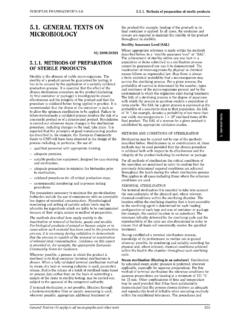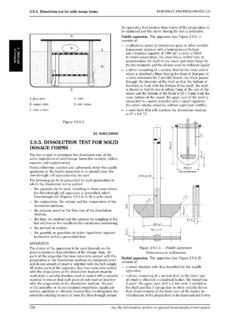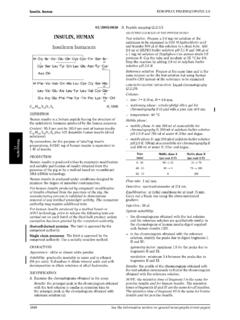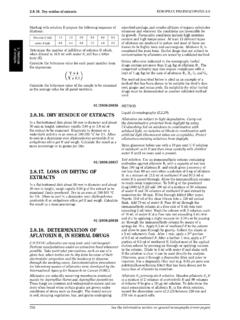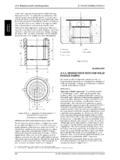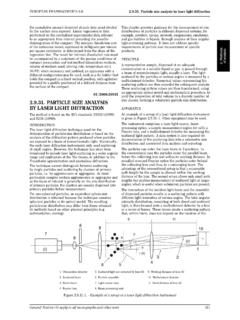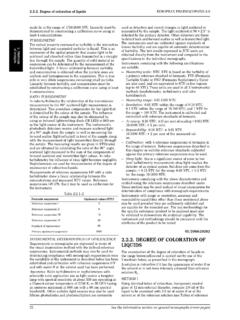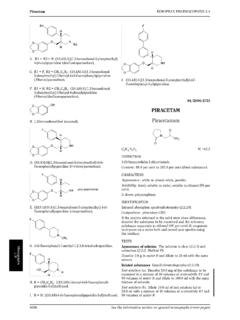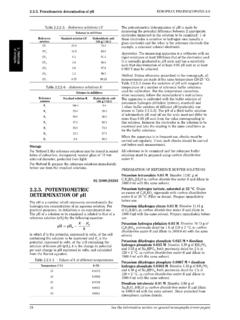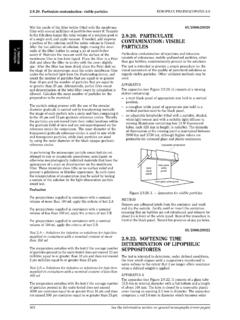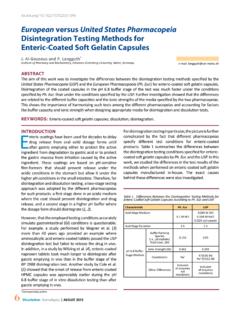Transcription of 2.6.12. MICROBIOLOGICAL EXAMINATION OF …
1 Depressor substancesEUROPEAN PHARMACOPOEIA and note whether the contractions producedby the preparation with the added histamine correspond tothe amount of histamine added. If this is not the case, or ifthe contractions caused by the substance to be examinedare not reproducible or if subsequent responses to high and low doses of histamine are diminished, the results ofthe tests are invalid and the test for depressor substances( ) ASodium gPotassium gCalcium chloride, gMagnesium chloride, gDisodium hydrogen phosphate gWater for injections Rsufficient to produce1000 mlSolution BSolution mlAtropine mgSodium hydrogen gGlucose gWater for injections Rsufficient to produce1000 mlSolution B should be freshly prepared and used within 24 DEPRESSOR SUBSTANCESC arryoutthetestonacatweighingnotlessthan2 kgandanaesthetised with chloralose or with a barbiturate thatallows the maintenance of uniform blood pressure.
2 Protectthe animal from loss of body heat and maintain it so thatthe rectal temperature remains within physiological a heparinised 9 g/l solution of sodium chloride into thecommon carotid artery and connect it to a device capable ofgiving a continuous record of the blood pressure. Insert intothe femoral vein another cannula, filled with a heparinised9 g/l solution of sodium chloride, through which can beinjected the solutions of histamine and of the substanceto be examined. Determine the sensitivity of the animal tohistamine by injecting intravenously at regular intervals,doses ofhistamine solution Rcorresponding to g g of histamine base per kilogram of body mass. Repeatthe lower dose at least 3 times. Administer the second andsubsequent injections not less than 1 min after the bloodpressure has returned to the level it was at immediatelybefore the previous injection.
3 The animal is used for the testonly if a readily discernible decrease in blood pressure thatis constant for the lower dose is obtained and if the higherdose causes greater responses. Dissolve the substance tobe examined in sufficient of a 9 g/l solution of sodiumchloride or other prescribed solvent, to give the prescribedconcentration. Inject intravenously per kilogram of bodymass ml ofhistamine solution R, followed by 2 successiveinjections of the prescribed amount of the solution to beexamined and, finally, ml ofhistamine solution , third and fourth injections are given not less than1 min after the blood pressurehas returned to the level itwas at immediately before the preceding injection. Repeatthis series of injections twice and conclude the test by ml ofhistamine solution Rper kilogram of body solution Rperkilogram of body mass is not greater than that to if the mean of the series of responses to the substanceis greater than the mean of the responses to ml ofhistamine solution Rperkilogramofbodymassorifanyonedose of the substance causes a greater depressor responsethan the concluding dose of the histamine solution.
4 Thetest animal must not be used in another test for depressorsubstances if the second criterion applies or if the responseto the high dose of histamine given after the administrationof the substance to be examined is less than the meanresponse to the low doses of histamine previously MICROBIOLOGICALEXAMINATION OF NON-STERILEPRODUCTS: TOTAL VIABLEAEROBIC COUNTThis general chapter presents 2 sets of tests. The 1stset givesthe reference methods for determining compliance withmonographs. Reference to this chapter in a monographtherefore implies compliance with the 1stset of tests,unless use of the 2ndset of tests has been authorised. Thetests in the 2ndset also constitute official methods of theEuropean Pharmacopoeia and may be referred to as such,notably in applications for marketing authorisation.
5 Itis intended to replace the 1stset by the 2ndset once themonographs concerned have been revised. The 2ndsetpresents tests developed in co-operation with the JapanesePharmacopoeia and the United States Pharmacopeia toachieve harmonised METHOD OF THE european PHARMACOPOEIAThe tests described hereafter will allow quantitativeenumeration of mesophilic bacteria and fungi that may growunder aerobic tests are designed primarily to determine whetherornotasubstancethatisthesubjectof amonographinthe Pharmacopoeia complies with the microbiologicalrequirements specified in the monograph in question. Whenused for such purposes, follow the instructions given below,including the number of samples to be taken, and interpretthe results as stated below. The tests may also be used forthe test forEfficacy of antimicrobial preservation( )asdescribed in the Pharmacopoeia.
6 They may furthermore beused for monitoring raw material quality and may be usedin association with guidelines on MICROBIOLOGICAL quality( ). When used for such purposes, for example by amanufacturer for raw materials and/or finished productmonitoring or for process validation, the conduct of thetests including the number of samples to be taken and theinterpretation of the results are matters for agreementbetween the manufacturer and the competent out the determination under conditions designedto avoid accidental contamination of the product to beexamined. The precautions taken to avoid contaminationmust be such that they do not affect any micro-organisms thatare revealed in the test. If the product to be examined hasantimicrobial activity, this must be adequately inactivators are used for this purpose, their efficacy andnon-toxicity versus micro-organisms are the total viable aerobic count by the membranefiltration method or the plate-count method, as prescribed inthe the information section on general monographs (cover pages) european PHARMACOPOEIA Total viable aerobic countTheMostProbableNumber(MPN)methodisr eservedfor bacterial counts when no other method is the nature of the product and the expected numberof micro-organisms.
7 Any method that is chosen must beproperly used in conjunction with ,thepour-plate method, the surface-spread method and themembrane filtration method may be OF THE SAMPLES ampling plan. Sampling of the product must follow awell-defined sampling plan. The sampling plan will bedependent on factors such as batch size, health hazardassociated with unacceptably highly contaminated products,the characteristics of the product and the expected level ofcontamination. Unless otherwise prescribed, use sample(s) of10gor10mlofthesubstanceorpreparationto beexamined,taken with the precautions referred to above. Select thesample(s)atrandomfromthebulkmaterialo rfromtheavailable containers of the preparation. If necessary, toobtain the required quantity, mix the contents of a sufficientnumber of containers to provide each sample, depending example of a sampling plan applicable to productswhere homogeneity with respect to the distribution ofmicro-organisms may be a problem, is the three-classsampling plan.
8 In this case five samples from each batch aredrawn and investigated separately. The three recognisedclasses are:(i) acceptable samples, samples containing less thanmCFU (colony-forming units) per gram or millilitre, wheremis the limit specified in the relevant monograph;(ii) marginal samples, with more thanmCFU but lessthan 10mCFU per gram or millilitre;(iii) defective samples, containing more than ml of the product to be examined in buffered sodiumchloride-peptone solution pH or in another suitableliquid. In general a one in ten dilution is prepared. However,thecharacteristicsoftheproductor therequiredsensitivitymay necessitate the use of other ratios. If the product isknown to have antimicrobial activity, an inactivating ,adjustthepHtoabout pH 7 and prepare further serial tenfold dilutions usingthe same products insoluble in ml of the product to be examined in buffered sodiumchloride-peptone solution pH or in another suitableliquid.
9 In general a one in ten suspension is prepared, but thecharacteristics of some products may necessitate the use oflarger volumes. A suitable surface-active agent such as 1 g/lof polysorbate 80 may be added to assist the suspension ofpoorly wettable substances. If the product is known to haveantimicrobial activity, an inactivating agent may be added tothe diluent. If necessary, adjust to about pH 7 and preparefurther serial tenfold dilutions using the same products. Homogenise 10 g or 10 ml of the product tobe examined with not more than half its weight of sterilepolysorbate 80 or another suitable sterile surface-activeagent, heated if necessary to not more than 40 C, or inexceptional cases to not more than 45 C. Mix carefullyand if necessary maintain the temperature in a water-bathor in an incubator.
10 Add sufficient pre-warmed bufferedsodium chloride-peptone solution pH to make a one inten dilution of the original product. Mix carefully whilstmaintaining the temperature for the shortest time necessaryfortheformationofanemulsionandi nanycasefornotmore than 30 min. Further serial tenfold dilutions may beprepared using buffered sodium chloride-peptone solutionpH containing a suitable concentration of sterilepolysorbate 80 or another sterile surface-active patches. Remove the protective coversheets ( release liners ) of ten patches of the transdermalpreparation using sterile forceps, and place them, theadhesive side upwards, on sterile glass or plastic trays. Coverthe adhesive surface with sterile gauze (or a woven-filtertype monofilament polymer grid), if necessary, and transferthetenpatchestoaminimumvolumeof5 00mlofbufferedsodium chloride-peptone solution pH containing suitableinactivators such as polysorbate 80 and/or lecithin.
